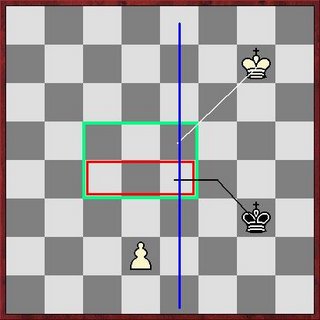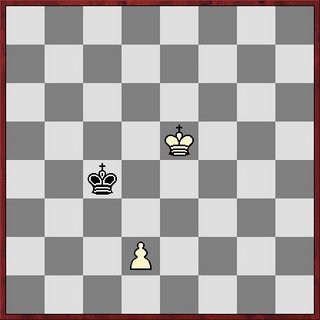Back to basics in pawn endings - pawn initial pos
King versus King + Pawn.
Pawn on its initial position – 2nd rank (same holds for the reverse situation).
Positions where the stronger king is far away from its pawn.
Attacking king = king with extra material, plays for a win.
Defending king = king alone, plays for a draw.
If the defending king can prevent the attacking king of reaching the critical squares on the fifth rank, the defender has succeeded to intervene. The pawn cannot brought safely in the vicinity of the attacking king.
If the attacking King can reach the critical squares on the fifth rank; the defending king must in the consecutive move capture or block the path of the pawn. The capture of the pawn is only possible if the king is already blocking the path of the pawn. This implies that for the defending king the square in front of the pawn becomes a destination square to draw.
With a pawn on its initial position there is no lateral attack possible. A pawn in its initial position can move two steps.
If the attacking king can reach the key squares on the fourth rank, and the defending king cannot capture the pawn in the consecutive move, the queening of the pawn becomes unstoppable.
A. Both kings compete for the destination squares on the same side of the pawn.
Practically speaking one has to look to the amount of tempos necessary to reach the key or critical squares for the attacking king and compare this with the amount of tempos that the defending king needs to reach its destination squares (the critical squares of the pawn)

B. Both kings race to the destination squares on the opposite side of the pawn.
Two basic positions with defending king always on the key square.
1. Attacking king on ‘critical’ square (5th rank square)
Whoever moves first wins.

Black to play plays d3; White to play plays Ke4 or better pawn d4.
2. Attacking king on ‘key’ square (4th rank square)
Attacking king wins always

If one can reduce the relative pos of both kings back to those two basic pos one can easily calculate the amount of moves both kings need to reach their destination squares. As the defending king cannot approach the pawn laterally, the destination square d3 can only be reached through a key square.
Furthermore with the attacking king to play the defending king has always one move less than the attacking king to reach its destination square, obtaining a draw. With an equal amount of moves the defending king always looses unless he has the move and the attacking king can only reach the critical square but not the key square.
I hope this will help me in the analysis of positions where the pawns are not yet blocked (dynamic)and on the same file (K+P versus K+P).
Pawn on its initial position – 2nd rank (same holds for the reverse situation).
Positions where the stronger king is far away from its pawn.
Attacking king = king with extra material, plays for a win.
Defending king = king alone, plays for a draw.
If the defending king can prevent the attacking king of reaching the critical squares on the fifth rank, the defender has succeeded to intervene. The pawn cannot brought safely in the vicinity of the attacking king.
If the attacking King can reach the critical squares on the fifth rank; the defending king must in the consecutive move capture or block the path of the pawn. The capture of the pawn is only possible if the king is already blocking the path of the pawn. This implies that for the defending king the square in front of the pawn becomes a destination square to draw.
With a pawn on its initial position there is no lateral attack possible. A pawn in its initial position can move two steps.
If the attacking king can reach the key squares on the fourth rank, and the defending king cannot capture the pawn in the consecutive move, the queening of the pawn becomes unstoppable.
A. Both kings compete for the destination squares on the same side of the pawn.
Practically speaking one has to look to the amount of tempos necessary to reach the key or critical squares for the attacking king and compare this with the amount of tempos that the defending king needs to reach its destination squares (the critical squares of the pawn)

B. Both kings race to the destination squares on the opposite side of the pawn.
Two basic positions with defending king always on the key square.
1. Attacking king on ‘critical’ square (5th rank square)
Whoever moves first wins.

Black to play plays d3; White to play plays Ke4 or better pawn d4.
2. Attacking king on ‘key’ square (4th rank square)
Attacking king wins always

If one can reduce the relative pos of both kings back to those two basic pos one can easily calculate the amount of moves both kings need to reach their destination squares. As the defending king cannot approach the pawn laterally, the destination square d3 can only be reached through a key square.
Furthermore with the attacking king to play the defending king has always one move less than the attacking king to reach its destination square, obtaining a draw. With an equal amount of moves the defending king always looses unless he has the move and the attacking king can only reach the critical square but not the key square.
I hope this will help me in the analysis of positions where the pawns are not yet blocked (dynamic)and on the same file (K+P versus K+P).


0 Comments:
Post a Comment
<< Home